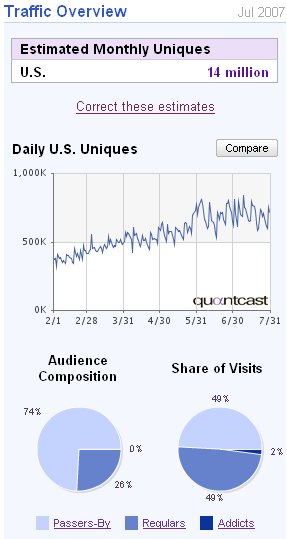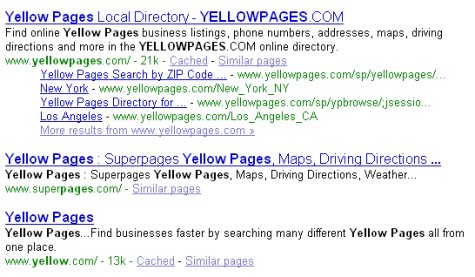By Michael Dorausch, D.C.
Whether you’re an investor, a local business owner, or both, this article on yellow page directories will help you to better understand who’s engaging the consumer, and who’s left their online phonebook on a virtual doorstep, still waiting for it to be picked up.
In a growing market of user generated Web 2.0 web sites, don’t let the idea of a stale “phonebook” directory fool you. Three of the five of these online directories are currently ranked among the hottest properties on the Internet.
While there’s hundreds of yellowpages style online directories, and thousands more targeting niche markets, I focused specifically on the top five in the industry. I incorporated 4 methods to come up with the results I did, and I also included some valuable keyword research, which I’ll share below.
The four methods of measurement I used include: Web Site Rank (compared to all ranked web sites in the US), Estimated Monthly Uniques (how many people in the US are visiting the web site), Stickiness (what percentage of visitors are repeat customers), and PageRank (aka PR). PR is basically a zero to 10 scoring system (the higher the number, the better) developed at Stanford University by Larry Page and used by Google to measure the relative importance of a particular web page. The final method (which I did not include in measurement) was website position when searching the term: yellow pages.
For the first three methods, I used quantcast, a third-party site traffic measurement tool which is publicly available for use. I chose quantcast for their accuracy, simplicity in their style, and clean graphics layout. I determined PageRank using the Google Toolbar on my Firefox browser.
 In the order of most popular directory first, let’s take a look at the top five online Yellow Pages directories, and the measurements I have gathered for each web site. I’m showing a screenshot for quantcast stats on yellowpages.com, so you can get a visual idea as to what we are talking about. The screenshot here shows traffic for AT&T’s yellow pages web site has been on a steady rise from February of 2007 to July of 2007.
In the order of most popular directory first, let’s take a look at the top five online Yellow Pages directories, and the measurements I have gathered for each web site. I’m showing a screenshot for quantcast stats on yellowpages.com, so you can get a visual idea as to what we are talking about. The screenshot here shows traffic for AT&T’s yellow pages web site has been on a steady rise from February of 2007 to July of 2007.
yellowpages.com
Rank #37
Estimated Monthly Uniques (US) = 14 million
Stickiness: 49% of visitors are regulars
PR: 8
superpages.com
Rank #65
Estimated Monthly Uniques (US) = 9.9 million
Stickiness: 45% of visitors are regulars
PR: 7
yellowbook.com
Rank #134
Estimated Monthly Uniques (US) = 5.7 million
Stickiness: 45% of visitors are regulars
PR: 7
dexknows.com
Rank #424
Estimated Monthly Uniques (US) = 2.6 million
Stickiness: 49% of visitors are regulars
PR: 0
yellow.com
Rank #2,491
Estimated Monthly Uniques (US) = 660,195
Stickiness: 28% of visitors are regulars
PR: 6
The big yellow guerrilla, with an estimated 14 million unique visitors in the month of July 2007, is AT&T owned YellowPages.com. AT&T has a huge advantage over all of the other dot-coms in the space simply due to direct type in traffic, people typing the words “yellow pages” into the URL bar on their browser. Try it out, type the phrase into your browser bar without using http, www, or .com and then hit go or enter. In the US you will likely be directed to AT&T’s yellowpages.com web site.
Besides direct type in traffic, it appears that brand loyalty and trust are an important factor behind the success of these web sites. I’ve seen television and print ad commercials for the four most popular directory dot-coms. Statistics for AT&T and DEX suggest that 49% of visitors are regular users, and both superpages and yellowbook are measuring at 45% for return visitors. It appears to me that the big players are building brand loyalty, and consumers for the most part are happy enough with the results, that they continue to use services that these web sites offer. One is also likely get a feeling of trust visiting one of these four main web sites, since they are all brand recognizable.
An interesting and valuable statistic to note regarding all of the top five web sites is that each receives slightly more traffic from a female audience, according to the reports on quantcast. That may just be the case for all online directories.
Google Universal Search Results
According to Google search results, YellowPages.com is recognized as the authority site in the industry. It has the coveted top position in Google search, which includes display of multiple portions of the web site appearing in search results. That’s also the secret behind why entering of the term “yellow pages” in the browser bar results in loading of the AT&T owned web site.

Superpages.com (owned by Idearc Media Corp.) holds position number two in search results. Notice Google does not display as much information (see screenshot) for superpages.com and yellow.com, as they do for the authority site.
But look at that, Yellow.com (owned by Marchex, Inc.) is number three when it comes to a straight search. Yellow.com gets my vote for hardest at working to rank well, despite lacking the traffic and branding the others command. It’s my observation that Yellow.com pulls lot’s of new traffic from search results for “yellow pages” whereas YellowPages and YellowBook likely get more direct type in traffic. While the rank, traffic, and stickiness for Yellow.com are far less than their nearest competitor, I can’t recall ever seeing any sort of print or television advertising for this web site. Notice that Yellow.com drops off in stickiness significantly when compared to the other four. I suspect this is likely due to a combination of weaker brand status and possibly level of trustability. While the web site may provide great directory services, it does appear rather generic to me. I’d suggest adding a trustworthy human image to the homepage. From a search engine optimization (SEO) perspective, Yellow.com is doing a spectacular job of holding themselves inside the top 10 of Google’s natural search results. They are also a top sponsored Link advertiser which puts their URL at the top of Google organic search results, in the sponsored Link category.
We’re not addressing these directories but I mention them to round out the top 10. Yahoo Yellow Pages is #4, AOL Yellow Pages is #5, MSN Yellow Pages is #6, and Switchboard.com is #7. Interesting pattern and probably a future topic.
Yellowbook.com holds position number eight, which isn’t to impressive, being that they have the traffic of 5.7 million visitors per month. To pull traffic for a “yellow pages” search, what yellowbook.com needs, is an inbound link campaign.
A directory called theYellowPages.com comes in at position number nine.
Notice that DEX does not crack the top 10 on Google for a Yellow Pages search. As a result, they likely rely heavily on purchased contextual ads, running along the Google sponsored links sidebar. An interesting observation I noticed regarding DEX is that they recently redirected their website from dexonline.com to dexknows.com. It’s my opinion that DEX is going to require a serious branding effort to get this new website anywhere near the numbers of the two biggest competitors in the space. The web site currently has a PR rank of 0, which indicates no PR has been passed since the web site was redirected. It may take months for the change to appear on the dexknows homepage. While we’re at it, DEX is the only of the five not to display a clean URL. A visit to the dexknows homepage currently brings up a “displayhome.ds” page instead of a “/” which could potentially affect search engine rankings.
One factor I believe is resulting in AT&T’s yellowpages.com holding dominance over the others is direct type in traffic and keyword relevance. The screenshot above is from research I did on Wordtracker.com, a keyword tracking web site. I did keyword research on the term “yellow” and you can see in the screenshot that the resulting term “yellow pages” is even more popular. The term “yellow book” gets significant search traffic as well, but it drops off considerably when compared to the yellow pages key phrase.
Doing a Google search for yellow book displays the branded directory in the top position, but yellowpages.com is right behind them, flexing those big yellow muscles of directory dominance.
I believe the information presented here is important to investors, it’s important to the folks working at and marketing these directories, and it’s critically important to those considering advertising with any of them. Professions like Chiropractic, Dentistry, & Law, tend to do a fair amount of yellow page directory advertising. This article provides good research and can be helpful in making educated decisions as to which directories hold the most value.
I plan to discuss yellow page directories as well as many niche online directories in greater detail. You are welcome to subscribe to the planetc1 RSS Feeds, as that’s where you will likely see updates on these topics.
– – – – – – – – – –
About the author: Michael Dorausch is an expert in the field of customer acquisition. He has had great success in assisting businesses to attract new clients, especially in niche service areas, such as the field of Chiropractic. Dorausch is a licensed and practicing chiropractor in Los Angeles, California.
planetc1.com-news @ 5:59 pm | Article ID: 1187485213




Comments are closed for this article!